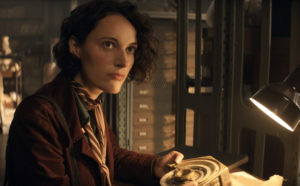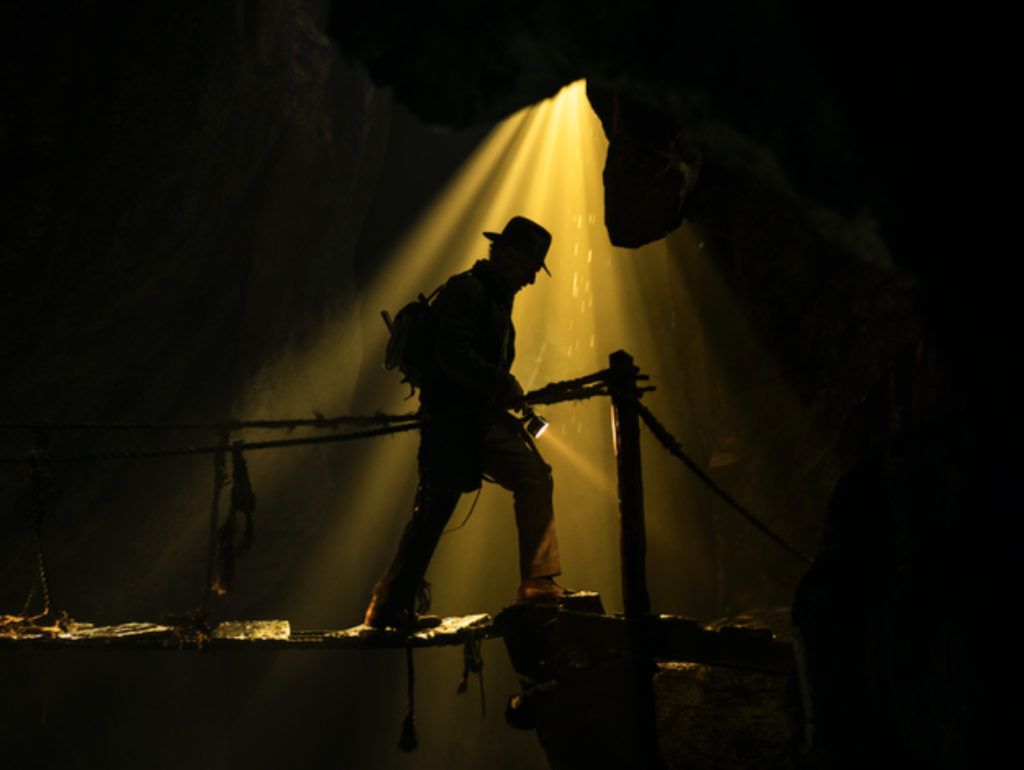Once again, Indiana Jones is on the hunt for a precious artifact. His goddaughter, Helena Shaw (played by Phoebe Waller Bridge) has absconded with Archimedes’ dial, the Antikythera — the MacGuffin in the franchise’s fifth installment, “Indiana Jones and the Dial of Destiny.” Conveniently, he learns from Sallah (John Rhys-Davies) of an auction in Tangier where Helena is heading to sell the object for a fortune.
As the digger-now-turned-cabbie drops off the famed archaeologist at the airport, on the cusp of the new adventure, Sallah triumphantly shouts, “Give ’em hell, Indiana Jones.”
The command is delivered on behalf of the audience, those of us eager to see octogenarian Harrison Ford don the fedora and crack the whip one last time.
Before the “Raiders” march could even hum, a car nearly collides with Indy. The moment is played for laughs, but, instead, James Mangold, Disney, and Lucasfilm collectively stick a thorn in fans’ eyes who’ve longed to cheer on their film hero — or any hero.
The scene is indicative of the film’s attitude toward one of cinema’s greatest and most popular characters. It’s an attitude that rinses and repeats Hollywood’s contrived, faux emotionalism when killing off heroes like Luke Skywalker, James Bond, and even Han Solo (also portrayed by Ford). And it poses an uncomfortable question: In the year 2023, is a relic like Indiana Jones even allowed to be a hero … even in his own movie?
“Dial of Destiny’s” answer is no. Indy drives none of the action, with the exception of a few nonexhilarating car chases. Helena bears most of the heavy lifting; in fact, she has memorized her father’s notes on the dial (unlike Indy or his father writing things down so they “wouldn’t have to remember”) and directs the plot across the globe, while using her quick wit to help the alleged main character escape Nazi clutches. The story, however, gives barely enough scraps to the archaeologist to fool audiences that he is an active participant in thwarting the Nazis from altering history.
This cynicism toward Indiana Jones, and all he stood for in the previous movies, rears its head in the film’s climax. After the de-aging, over-bloated opening prologue, Indy is a drunk, depressed man grieving over the loss of his son and failed marriage with Marion Ravenwood. His students (perhaps stand-ins for Gen-Zers) care little for him or the subject, a far cry from when they fawned over him in “Raiders of the Lost Ark” and “The Last Crusade.” However, the movie presents an arc: the MacGuffin, being a time travel device, offers Indy a chance to prevent his past failures from ever existing. He can literally rewrite his history.

But Indy makes no attempts at doing just that, which makes the climax’s dilemma — returning to the film’s present-day to confront his grief or staying in antiquity — an utterly pointless journey.
Compare this to the previous films in the franchise. In “Raiders,” Indiana begins as an agnostic, who doesn’t “believe in magic, a lot of superstitious hocus-pocus,” dismissive of the Ark of the Covenant’s power. Yet, when the wrath of God is imminent, he chooses to fear the Lord rather than incur his destruction (i.e., “Keep your eyes shut”). Ultimately, his progression toward faith is solidified when he frustratingly states, “They don’t know what they’ve got there.” And, of course, he restores his relationship with Marion.
At the “Temple of Doom’s” outset, Indy is more of a grave robber than archaeologist, searching for “fortune and glory.” But he forgoes his quest for the legendary Sankara Stones after witnessing child slave labor inflicted by the Thuggee cult. The true glory is his gift to a poor Indian village: the return of its children. Meanwhile, in “The Last Crusade,” Indy states, “I didn’t come for the cup of Christ, I came to find my father.” When he renounces the Holy Grail for a new kinship with his father, we know Indy means what he says.
Even in the maligned “Kingdom of the Crystal Skull” he gains a son and wife at a point where “life stops giving us things and starts taking them away,” by rescuing them from the Soviets and “inter-dimensional beings.” Here is a hero who chooses humanity over the artifact.
But in “Dial of Destiny,” Indy is given no moral choice, at least none that makes sense. Thankfully, the rumors of Indy dying in the past, while passing the mantle to Helena, did not make the final cut. However, the third act would have made more thematic sense if the characters traveled to the 1940s — or some place within Indy’s own timeline — so he could reject “fixing” his past mistakes, while not altering history to achieve his own selfish ends.
But this is not where the filmmakers go, thematically or in spacetime. Instead, audiences are given an obviously, haphazardly reshot ending where Indy makes no decision on whether to face his overwhelming grief or despairingly avoid his troubles (and possibly destroy history, the very subject he loves); Helena must — and does — decide for him.
When Indy does see Marion again, and the pair begin reconciling, the moment means nothing because he did nothing at the most critical point. With Helena deciding for the doddering old man, Indy is allowed to exist, but has no impact on the greater landscape. He is an object of the past to be exploited for box-office grosses to fund progressive causes, though one too important that Disney and Lucasfilm could not completely kill off lest they incur the fans’ wrath.
But like Belloq — Indy’s nemesis in “Raiders” — the filmmakers failed to comprehend the character’s powerful appeal, destroying another intellectual property and audiences’ trust in the process, as well as their own pursuit of fortune and glory (the movie is on track to be a box-office bomb). If they were trying to appeal to the ‘Sallahs’ (fans), there was nothing to cheer about beyond seeing Ford in the outfit. If they were trying to grab the attention of the “students” (Gen-Zers), the film was too long and dull.
Ultimately, “Dial of Destiny” diminishes the action-adventurer that inspired a generation or two of filmmakers (and even archaeologists), into a depressed, passive character. Yet his rough-and-tumble heroism, they forget, is what charmed moviegoers in the first place.

